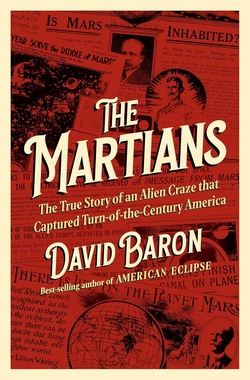Centauri Dreams
Imagining and Planning Interstellar Exploration
Planetary Lensing: Enter the ‘Terrascope’
I’m always fascinated with ideas that do not disrupt the known laws of physics but imply an engineering so vast that it seems to defy practical deployment. Centauri Dreams readers are well aware by now of some of Robert Forward’s vast mental constructions, including lightsails in the hundreds of kilometers and enormous lenses in the outer Solar System as big as some US states. But such notions abound in the realm of interstellar thinking. Thus Clifford Singer’s ideas on pellet propulsion to a receding starship, which from the mathematical analysis require an accelerator 105 kilometers long, an engineering nightmare.
But then, when we reach sizes like these, we might ask ourselves whether we’re not overlooking the obvious. When Cornell’s Mason Peck went to work on wafer-scale spacecraft, one futuristic notion that occurred to him was to charge swarms of tiny ‘sprites’ through plasma interactions and use Jupiter’s magnetic field as a particle accelerator, pushing the chips to thousands of kilometers per second. That gets you to Proxima Centauri at, conceivably, a tenth of lightspeed. And instead of building a vast accelerator, you use the one the Solar System already has.
Columbia University’s David Kipping likewise investigates what we can do with natural objects. Years ago, he became fascinated with Claudio Maccone’s ideas for a FOCAL mission, which would use the Sun’s own mass as the instrument for ‘bending’ starlight to a focus at about 550 AU, one that might be exploited by future deep space telescopes. I put ‘bending’ in apostrophes because actually the light never bends, but flies straight and true through spacetime curved by the presence of mass. The Sun has 300,000 times the mass of the Earth, a useful object!
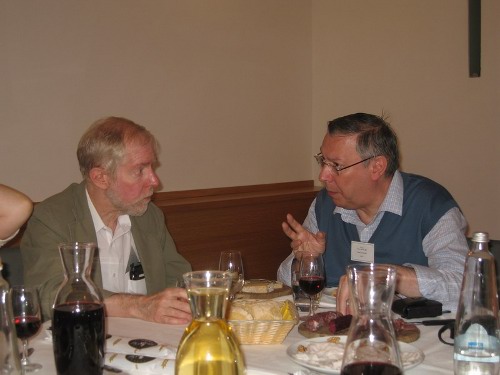
Image: Writing about Italian physicist Claudio Maccone gives me the chance to tap a favorite memory. Here I’m at the left, having lunch with Claudio ten years ago in the Italian Alps. This was one of many sessions in which Claudio helped me understand the implications of gravitational lensing. Credit: Roman Kezerashvili (City University of New York).
No one in the rich history of gravitational lensing concepts from Einstein through Von Eshleman and on to Maccone, Geoff Landis and Slava Turyshev has done more for the field than Maccone himself, having submitted a proposal to the European Space Agency for FOCAL as far back as 1993, and having authored the key text, Deep Space Flight and Communications: Exploiting the Sun as a Gravitational Lens (Springer/Praxis 2009).
A Lens the Size of the Earth
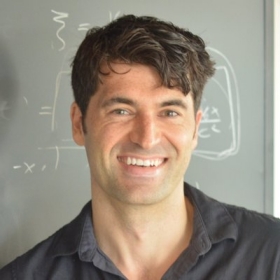
Of course, in our current stage of technological development, FOCAL itself is quite a reach, given our problems in getting to the outer Solar System — our farthest-flung craft even now are but a third of the way to where the lensing phenomenon could begin to be exploited. Well aware of this, David Kipping wondered if there wasn’t a way to explore the ‘bending’ of light in a different way, one that could help us learn how to untangle complex lensed images and develop near-term technologies at distances much closer to home. And it turns out there is, although it’s not a proposal that relies on gravitational lensing but rather the refraction of light.
Image: Columbia University physicist David Kipping.
Kipping wants us to consider the Earth as the source in a concept he calls the Terrascope. Although Maccone has considered the gravitational lensing properties of individual planets, the effect is small. Kipping reminds us that bending light through refraction has been used since the earliest telescopes. Refraction happens when light moves from a medium like air to a dense medium like glass. The result: Magnification as well as amplification, depending on the size of the lens.
The problem: Keep making larger and larger refracting telescopes and the lenses begin to deform under gravity. Reflector telescopes solve many of the problems of refractors, but we can see how far we’ve pushed their limits when we consider how we’ve had to move to segmented mirrors like the 36-mirror Gran Telescopio Canarias. Segmented mirrors cope with the deformation problems of a single large mirror but demand powerful computing resources. As their size continues to increase, costs skyrocket.
Kipping was originally inspired by the ‘Green Flash’ phenomenon that is the result of the refraction of the Sun’s light at sunset or sunrise. It lasts no more than a second or two, and appears because blue light is attenuated by scattering in the atmosphere as sunlight is spread into its constituent colors. The Columbia physicist, working thirteen years ago on a master’s thesis at Cambridge, realized that at a certain distance from Earth, if the Sun were directly behind our planet, a global green flash would appear, forming a green ring around Earth.
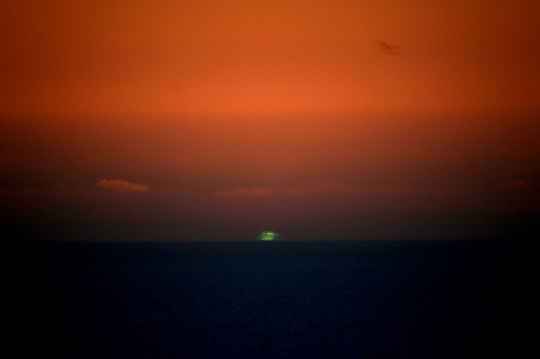
Image: The green flash as seen in Santa Cruz, VA. Credit: Brocken Inaglory CC BY-SA 3.0.
And what happens with more distant starlight? If the Earth is in front of a star, light from the star is deflected by the Earth’s atmosphere by about half a degree as it enters, and another half a degree as it exits — for those light rays that skim the surface. This sets up a focal point at a distance less than the Earth’s distance from the Moon. Even more significantly, a focal line is created as we consider light rays that enter the atmosphere higher up. Here the bending effect is somewhat less, but we also begin to mitigate atmospheric effects that would put noise in our data.
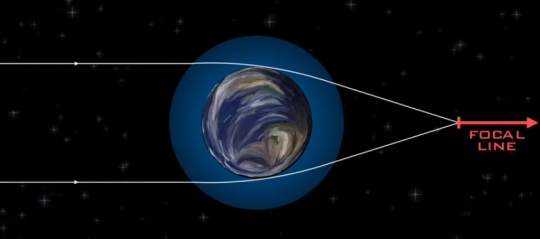
Image: Light from a distant star is deflected by the atmosphere of the Earth by half a degree. After skimming the surface, it is bent again as it exits the atmosphere by one-half a degree. Light entering the opposite hemisphere does the same, creating a focal point. Rays entering the atmosphere higher up bend less because the atmosphere is thinner with altitude, so the result is a focal line. The trick is knowing which light can be effectively sampled. Image credit: David Kipping.
As you can infer from the image above, light that skims the surface of the Earth would encounter too many obstacles to be helpful, but light rays encountering the atmosphere at higher altitudes can give us a focal point at the distance of the Moon. Even here, though, we run into scattering and extinction effects produced by the atmosphere, which depend upon the wavelength of the light we’re looking at.
Moreover, clouds are a factor, meaning we have to choose light that enters the atmosphere higher still. In his paper, Kpping argues that a detector placed at the Hill Sphere distance, about four times the distance between the Earth and the Moon, is positioned to intercept light that would have skimmed the Earth’s atmosphere at an altitude of 14 kilometers. As he notes in a recent email: “So put a detector at the Lagrange point, look back at the Earth, block out the disk of the Earth itself, and around the rim you should see light from distant stars lensed into ring-like structures.”
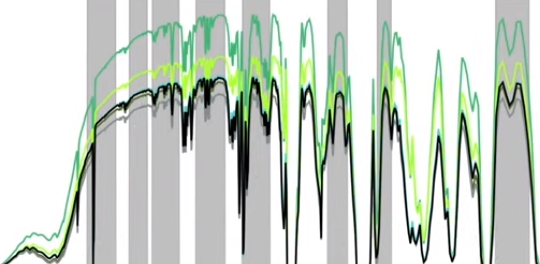
Image: Extinction effects for a terrascope at the Hill Sphere distance, roughly 4 Earth radii. Here, most of the infrared spectrum becomes usable for lensing. Image credit: David Kipping.
The Hill Sphere distance is benignly close compared to the gravitational lens at 550 AU, which means it offers an interesting observing possibility at a distance we’re experienced at reaching — the James Webb Space Telescope will work within this range. If we can truly exploit this phenomenon, we can get amplifications in the range of 22,500, Kipping estimates. This is actually a conservative estimate, but probably necessarily so, as he explains in his email:
“Now the Earth is much smaller than the Sun, so the amplification is not comparable with FOCAL but still impressive. I compute it is 45,000 after accounting for clouds and extinction losses, and is fairly wavelength independent beyond a micron (refraction doesn’t change much beyond 1micron). I think you might lose up to half of that due to half of the Earth being in daylight, which obviously would be a bright noise source. So removing that, I think 22,500 amplification is more realistic. That means you would turn a 1 meter detector into a ~150 meter effective aperture, amplifying sources by nearly 11 magnitudes.”
A one-meter detector analyzes light in a way that a 150-meter space telescope would otherwise be capable of, without, of course, the vast cost incurred by the latter (remember that even the JWST, a 6.5-meter instrument, has already incurred costs in the range of $10 billion).
But how would we use an effect that allowed us to look only at whatever happens to be behind the Earth during the observing period? I want to talk about this paper more tomorrow, and also alert you to Kipping’s video description of the idea. There are also obvious issues having to do with atmospheric effects and questions about occultation methods in this work. But there are enough serious advantages — we’ll look at several more tomorrow — to make us delve deeper.
The paper is Kipping, “The ‘Terrascope’: On the Possibility of Using the Earth as an Atmospheric Lens,” accepted at Proceedings of the Astronomical Society of the Pacific (abstract).

Summer Break
And boy do I need it! See you in two weeks.

TESS: Concluding First Year of Observations
If it seemed amazing to me that 50 years had gone by since Apollo 11, it surprises me as well to realize that, on a much shorter scale, the Transiting Exoplanet Survey Satellite (TESS) has been at work for a full year. In a recent news release, NASA is calling this “the most comprehensive planet-hunting expedition ever undertaken,” presumably a nod to the mission’s broad sky coverage as opposed to the sharply confined field of view of the Kepler mission.
Whereas Kepler took a ‘long stare’ at its starfield in Cygnus and Lyra, TESS keeps alternating what it sees, looking at a 24-by-96 degree section of sky for 27 days at a time. Moreover, TESS scientists are homing in on stars much closer to our Solar System. While Kepler was looking along the Orion arm of the galaxy at stars generally between 600 and 3,000 light years out (more distant stars were too faint to observe transit lightcurves), TESS puts the emphasis on stars closer than 300 light years, though with a similar method of looking for transits. The mission will wind up studying 85 percent of the sky, an area 350 times greater than Kepler.
George Ricker, TESS principal investigator at MIT, is thinking the mission he leads has had an outstanding first year:
“The pace and productivity of TESS in its first year of operations has far exceeded our most optimistic hopes for the mission. In addition to finding a diverse set of exoplanets, TESS has discovered a treasure trove of astrophysical phenomena, including thousands of violently variable stellar objects.”
That last bit is a nod to the fact that even as TESS hunts exoplanets, beginning with the southern sky in July of 2018, it also has been on the lookout for supernovae and other deep sky objects within its line of sight. The exoplanet haul in the past year includes 21 planets, with 959 candidates still waiting for confirmation by ground-based telescopes (the candidate list will swell enormously as the voluminous data yet to be analyzed comes into play). Its first year concluded, TESS is now looking at the northern sky. Bear in mind that the sections of sky TESS looks at can overlap — some parts of the sky thus wind up being observed for almost a year.
This is helpful, because an area near the poles in its observational ‘sphere’ will be under constant observation, producing targets for follow-up with the James Webb Space Telescope. The video below is useful for illustrating the TESS sky-coverage technique. Have a look, while pondering the words of Padi Boyd, a TESS project scientist at NASA GSFC:
“Kepler discovered the amazing result that, on average, every star system has a planet or planets around it. TESS takes the next step. If planets are everywhere, let’s find those orbiting bright, nearby stars because they’ll be the ones we can now follow up with existing ground and space-based telescopes, and the next generation of instruments for decades to come.”
Among the early TESS catches:
- HD 21749c, the first Earth-size planet the mission has found. The world orbits a K-class star with about 70 percent of the mass of the Sun, located 53 light years away in the constellation Reticulum, one of two planets identified in this system;
- A number of multi-planet systems, like that around L98-59, which includes a planet (L98-59b) between the size of Earth and Mars, the smallest yet found by TESS. Here the host star is an M-dwarf about a third the mass of the Sun, 35 light years away in the constellation Volans;
- Three exocomets identified in the Beta Pictoris system. A comet’s lightcurve differs significantly from that of a transiting planet because of the extended cometary tail. These discoveries demonstrate the ability of TESS to identify tiny objects around young, bright stars, and should lead to future exocomet detections that can supply information about planet formation;
- Six supernovae occurring in other galaxies, among them ASASSN-18rn, ASASSN-18tb and ATLAS18tne, found before ground-based surveys could identify them.
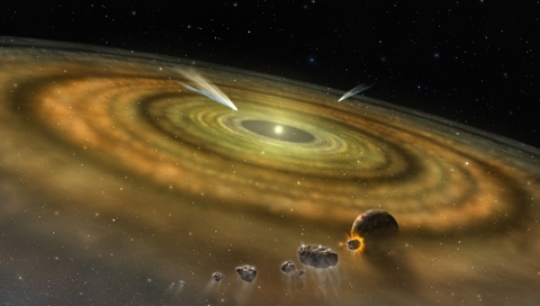
Image: Astronomers have found clear observational evidence of exocomets around the bright star Beta Pictoris, located some 65 light-years from Earth. At just 20 million years old, Beta Pictoris is relatively young, meaning it’s still surrounded by a disk of gas and dust known as a protoplanetary disk, seen here in this artist’s concept. Credit: NASA/FUSE/Lynette Cook.
We’re extremely early in the analysis of TESS data, considering that an object must make three transits to be considered an exoplanet candidate, after which a number of additional checks remain to be made before the object is submitted to study by ground-based telescopes. When the dust settles, TESS is expected to land more than 20,000 exoplanets, dozens of them the size of Earth and up to 500 planets less than twice the size of Earth. Of the total haul, scientists anticipate that the observatory will find about 17,000 planets larger than Neptune.
“The team is currently focused on finding the best candidates to confirm by ground-based follow-up,” said Natalia Guerrero, who manages the team in charge of identifying exoplanet candidates at MIT. “But there are many more potential exoplanet candidates in the data yet to be analyzed, so we’re really just seeing the tip of the iceberg here. TESS has only scratched the surface.”

VERITAS: Strengthening the Optical SETI Search
Breakthrough Listen has just announced a new optical SETI effort in partnership with the VERITAS Collaboration. The news took me by surprise, for VERITAS (Very Energetic Radiation Imaging Telescope Array System) generally deals in high-energy astrophysics, with a focus on gamma rays, which signal their presence through flashes of Cherenkov radiation when they strike the Earth’s atmosphere. Here, the array is being used to look for technosignatures, as Andrew Siemion (UC- Berkeley SETI Research Center) explains:
“Breakthrough Listen is already the most powerful, comprehensive, and intensive search yet undertaken for signs of intelligent life beyond Earth. Now, with the addition of VERITAS, we’re sensitive to an important new class of signals: fast optical pulses. Optical communication has already been used by NASA to transmit high definition images to Earth from the Moon, so there’s reason to believe that an advanced civilization might use a scaled-up version of this technology for interstellar communication.”

Image: View of the Fred Lawrence Whipple Observatory basecamp and the VERITAS array. Credit: VERITAS.
So the search for faint optical flashes that could signal the presence of an extraterrestrial civilization deepens, complementing the optical SETI work currently underway at Breakthrough Listen as well as its ongoing survey at radio frequencies. VERITAS brings four 12-meter telescopes located at the basecamp of the Fred Lawrence Whipple Observatory on Mount Hopkins in Arizona into the mix. This is quite an exoplanet venue: The observatory has facilities at different elevations, including exoplanet arrays for HAT (Hungarian-made Automated Telescope), the MEarth project and MINERVA, all three of these robotic.
In the Breakthrough Listen effort, VERITAS will be looking for pulsed optical beacons with durations as short as several nanoseconds, for at timescales like these, an artificial beacon could outshine any stars located in the same region of sky. All four telescopes will be used simultaneously, which should assist the effort in screening out false positive detections.
Although I hadn’t realized it until looking further into VERITAS, the array has already seen use in a search of Boyajian’s Star for such pulses (see Abeysekara et al., “A Search for Brief Optical Flashes Associated with the SETI Target KIC 8462852,” abstract here). You’ll recall that this star has received intense scrutiny because of its unusual pattern of dimming, which did not correspond to planetary transits and raised questions about the source of the lightcurve variations.
Now VERITAS goes to work on stars not already found on Breakthrough Listen’s primary star list. The numbers are striking: Breakthrough Listen calculates that if a laser delivering 500 terawatts in a pulse lasting a few nanoseconds were located at the same distance as Boyajian’s Star (an F3V-class object in Cygnus approximately 1470 light years away) and pointed in our direction, VERITAS would be able to detect it.
Most stars in the Breakthrough Listen target list, however, are considerably closer. Hence the VERITAS search will be sensitive to pulses a factor 100 – 10,000 times fainter still. Thus an array built with the purpose of studying very-high-energy gamma rays proves adaptable to a search for technosignatures, with UC-Santa Cruz physicist David Williams, one of the effort’s leaders, saying “It is impressive how well-suited the VERITAS telescopes are for this project.” Williams will work in collaboration with Jamie Holder (University of Delaware) and Andrew Siemion’s Breakthrough Listen team at UC-Berkeley’s SETI Research Center (BSRC).
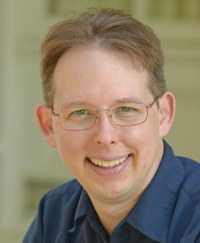
While we’re on the topic of SETI, let me also call your attention to a new resource that Penn State’s Jason Wright and Alan Reyes have created. Go to the NASA ADS site and include in your search terms ‘bibgroup:SETI’. I just searched, for example, using ‘author:”maccone” bibgroup:SETI’ and came up with 56 hits. SETI has been short on bibliographical resources, so this is promising stuff. You’ll need to familiarize yourself with the search syntax, but it’s not at all difficult, and will reward those looking to firm up a citation or check on the status of a particular scientist’s work. Wright and Reyes have submitted a paper on the bibliography to JBIS. For more, see Towards a Comprehensive Bibliography for SETI.
Image: Penn State’s Jason Wright. Credit: PSU.

Sail Deployment: Reflections on LightSail 2
One thing that James E. Webb insisted on during his tenure as NASA administrator was that the space program was larger than an attempt to get humans to the Moon. The man who did so much to ensure that Apollo would succeed, and who will be rightfully honored in the form of the James Webb Space Telescope, was a proponent of exploration throughout the Solar System through robotic craft, and weather and communications satellites that would become part of a permanent reliance on a growing space infrastructure. Marc Millis noted some of the results in his recent essay.
For while the frustration of abandoning the Moon in the 1970s lingers, we do have over 4600 spacecraft in Earth orbit, many of them doing the kind of work Webb envisioned. We’ve completed the initial reconnaissance of the Solar System and made our first tentative ventures into the Kuiper Belt and out past the heliopause. We’re charting exoplanets and looking to explore Saturn’s largest moon. So these are things to keep in mind when frustration begins to build.
The anniversary of Apollo’s first landing was a time for looking back, but The Planetary Society has just reminded us that we have to keep looking ahead as well. With the successful deployment of the solar sail aboard LightSail 2, we are seeing the kind of change Millis talked about in action. Much of the space business has turned commercial, while we continue to sort out how to handle the change (SLS or Falcon Heavy?), and in the midst of this, private organizations using off-the-shelf hardware can produce crowd-funded missions of real value.
SAIL DEPLOYMENT COMPLETE! We're sailing on SUNLIGHT!!!!! pic.twitter.com/PA74NMa7Ry
— Planetary Society (@exploreplanets) July 23, 2019
We’re in that confusing time — one that future historians will be able to sort out more readily than we can define it today — when the pace of technological change drives new models for the accomplishment of grand goals. How we interrelate big government projects with corporate space activities and private contributions will define an era that will one day have its own name, just as the 1960s could be partially defined by the term ‘Space Race.’ And it’s understandable that Planetary Society CEO Bill Nye should be proud of what his organization has accomplished: “We are advancing space science and exploration,” says Nye. “We are democratizing space. We are innovating.”
Apollo 8 gave us gorgeous photographs of our planet seen entire, a blue and brown crystal filling the frame. Now we have LightSail 2’s view of Earth, showing vast portions of the Pacific Ocean and part of the North American landmass. CubeSats in their various configurations make it possible for organizations like The Planetary Society as well as universities and other private groups to contemplate missions that move the ball forward. In the case of LightSail 2, we will have learned more about sail deployment, and orbit raising by the pressure of sunlight alone.
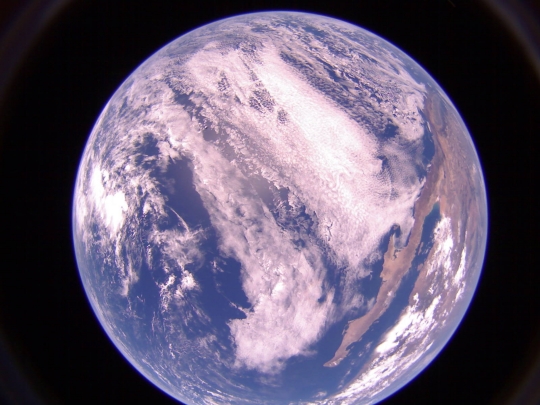
Image: This image of Earth, which shows the Pacific Ocean with Baja California and Mexico on the right, was captured by LightSail 2 on 18 July 2019 at 21:45 UTC while the spacecraft was in range of its ground station at Cal Poly San Luis Obispo in California. Though LightSail 2’s altitude is only 720 kilometers, its 185-degree, wide-angle camera lenses allow it to capture horizon-to-horizon Earth imagery. Credit: The Planetary Society.
The deployment command to LightSail 2 went out at about 1445 EDT (1845 UTC) on the 23rd, with the momentum wheel, responsible for orienting the sail in relation to the Sun, spinning up successfully. Now we wait for images of the deployed sail, which should be downloaded today.
Here’s a photo of the LightSail 2 team set up for sail deployment. It’s impossible to ignore the contrast between the Mission Control operations we see at NASA (think of the operation Chris Kraft ran!) and the ad hoc effort at Cal Poly. What makes this possible is vision, public financial support and technology trends working in favor of small, light spacecraft, not to mention gritty persistence. I’ll feel better when I’ve seen actual sail images, but for right now, things look good, and the entire Planetary Society team deserves our congratulations.
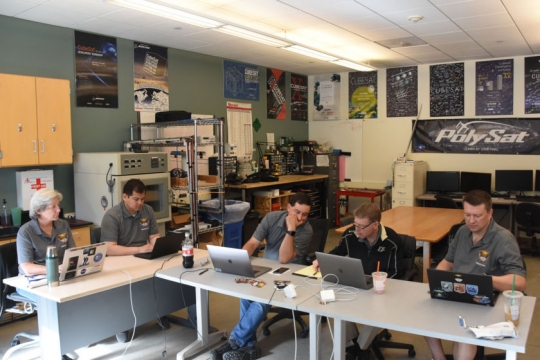
Image: This image shows The Planetary Society’s LightSail 2 team on console prior to sail deployment on 23 July 2019 at the Cal Poly CubeSat lab in San Luis Obispo, California. From left: Barbara Plante, Founder and President, Boreal Space; Alex Diaz, Avionics Engineer, Ecliptic Enterprises Corporation; John Bellardo, Associate Professor, Cal Poly San Luis Obispo; Dave Spencer, LightSail Project Manager, Associate Professor at Purdue University; Bruce Betts, LightSail Program Manager, Planetary Society Chief Scientist. Credit: The Planetary Society.
You can track LightSail 2’s condition on its own Mission Control page, which offers data on temperature, degree of rotation, control mode and location over the Earth. 40,000 private donations (totalling in the region of $7 million) went into LightSail 2 over 10 years. The results of the effort will also feed a NASA project called Near Earth Asteroid Scout, which will likewise employ CubeSat technology to visit an asteroid early in the 2020s. Launched by a Falcon Heavy, LightSail 2 emphasizes today’s mix of commercial, corporate and private effort.
I fall back on what Marc Millis said in these pages on Monday:
It is my hope that progress will continue along all these fronts and improve the human condition. The next steps toward the Moon, Mars and recreational spaceflight will usher in a new era, a suitable name for which will probably be conceived years later. It’s certainly no longer a “space race” with only one finish line. It is the beginning of a new stage of humanity.

Remembering Chris Kraft
As a poignant and unexpected coda to the celebrations of the Apollo 11 anniversary we learn of the death of Chris Kraft, the man who created NASA’s Mission Control from scratch in the early days of the manned space program and was head of Flight Operations during that critical period. Death came at age 95 to a man who worked at ground zero in the fraught days of Mercury and Gemini, serving as flight director for all the Mercury missions and seven of the Gemini flights. Neil Armstrong would say of Kraft that he was “the ‘Control’ in Mission Control.”
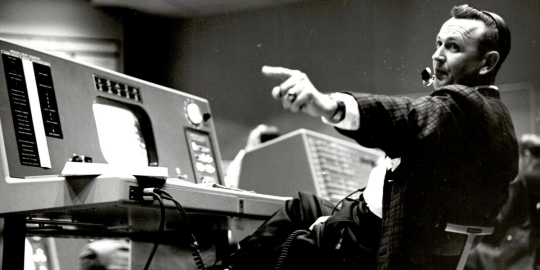
Image: Christopher Kraft, flight director during Project Mercury, works at his console inside the Flight Control area at Mercury Mission Control in Houston. Kraft, the founder of NASA’s Mission Control, died Monday, July 22, 2019, just two days after the 50th anniversary of the Apollo 11 moon landing. He was 95. Credit: NASA via AP.
After his work with Gemini, Kraft moved up NASA management ranks and became a senior planner for the Apollo program. He went on to lead the Johnson Space Center in Houston and was deeply involved in the Space Shuttle program, though for many of us, he will always be the voice we heard in TV coverage of missions dating back to Alan Shepard’s suborbital shot in 1961, a mission during which he later admitted he was ‘shaking like a leaf’ (it certainly never showed, and Kraft added that his nerves steadied considerably after the Shepard flight).
The challenge presented to Kraft was immense, coordinating the inputs from the dozens of controllers who tracked spacecraft operations while balancing teams of researchers and engineers in an environment that could demand quick, decisive action to save a mission. Go to Houston today and you’ll see that Mission Control Center at JSC is named after Kraft, whose legacy is not just a room of controllers but the very concept of flight management still in use.
Al Jackson, who knew Kraft through his work on the Lunar Module Simulator, wrote this morning with his own recollection of the man, calling Kraft ‘the best technical manager I ever met,’ and adding:
The training simulator group rarely had to meet with him, but every now and then the crews would want some kind of modification to the simulators, so we would go to his office. I always liked those meeting because they were short! The problem would be presented and Kraft, once it was clear to him, would make the decision on what to do. There was no extra talk; he just said “you will do this and this and this”… and the meeting was over usually in less than 30 minutes. I have never met another technical manager like him. He was an exceptional man.
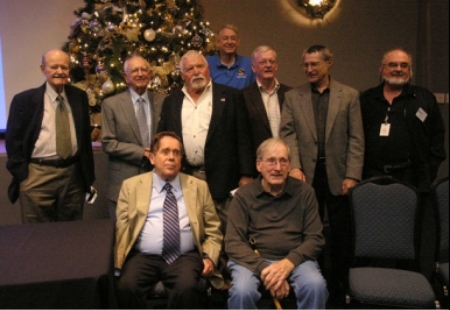
Image: A 40th anniversary panel on Apollo 8 organized by Al Jackson in 2008. Left to right: Marty Jenness, Dr. Christopher Kraft, John Llewellyn, Dr. Glynn Lunney (with Ken Young behind him), Emil Shiesser, Al Jackson. Front row: Hal Beck, Rod Rose. Credit: Al Jackson.
Retiring in 1982, Kraft maintained an active interest in the space program as he pursued consulting options. This NPR article quotes him as he reflected on his career:
“I flew on every flight — vicariously. I didn’t have to go. I mean that. I used to tell people back then when we’re flying, I have this feeling that’s what we’re doing all the time. And then when we stop flying, I don’t believe we did it. That was a strange feeling. … I was in my revelry when we were flying. My people were the same way. It was such a tremendous pleasure out of making things happen well and safely and knowing that they were contributing to that part of the program. I think it was extremely important to all of us and that was our payoff. We didn’t make any money working for the government. But we sure got a hell of a lot of enjoyment out of it.”
This has been a summer of memories as we recalled the events leading to the Apollo landings. Playing through all of that history has been the steady and disciplined guidance provided by people like Chris Kraft, who were tasked with a job — going to the Moon! — that seemed insurmountable at a time when America’s experience in space was limited to a single 15-minute suborbital flight. There were truly giants in those days, and Chris Kraft was one of them.

